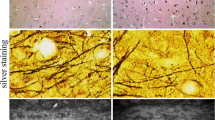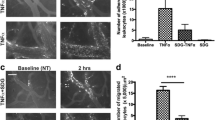Abstract
Peroxisome proliferator-activated receptor gamma (PPARƔ) contributes to human immunodeficiency virus (HIV)-1-induced dysfunction of brain endothelial cells. The aim of the present study was to evaluate the protection mechanism of PPARƔ against Tat-induced responses of adhesion molecules. We measured the protein expressions of intercellular adhesion molecule (ICAM)-1 and vascular cell adhesion molecule (VCAM)-1 in human brain microvascular endothelial cells (hCMEC/D3) and C57BL/6J mouse brain microvessels with Western blotting and immunofluorescent labeling. The mRNA levels of ICAM-1 and VCAM-1 were determined by real-time reverse-transcriptase polymerase chain reaction. HIV-1 Tat induced overexpression of ICAM-1 but not VCAM-1 in both hCMEC/D3 and brain microvessels, this response was attenuated by treatment with the PPARƔ agonist rosiglitazone. Tat-mediated upregulation of ICAM-1 and VCAM-1 levels were abolished by the addition of PPARƔ antagonist GW9662 and the Akt inhibitor KP3721, indicating that Akt signaling is involved in the PPARƔ-mediated protection of Tat-induced adhesion molecule upregulation. These results show that Akt signaling plays a key role in PPARƔ’s vascular inflammatory effects that contribute to blood–brain barrier damage.



Similar content being viewed by others
References
Heaton RK, Clifford DB, Franklin DR Jr, Woods SP, Ake C, Vaida F, Ellis RJ, Letendre SL, Marcotte TD, Atkinson JH, Rivera-Mindt M, Vigil OR, Taylor MJ, Collier AC, Marra CM, Gelman BB, McArthur JC, Morgello S, Simpson DM, McCutchan JA, Abramson I, Gamst A, Fennema-Notestine C, Jernigan TL, Wong J, Grant I (2010) HIV-associated neurocognitive disorders persist in the era of potent antiretroviral therapy: CHARTER Study. Neurology 75:2087–2096
Tavazzi EMD, Sullivan P, Morgello S, Fischer T (2014) Brain inflammation is a common feature of HIV-infected patients without HIV encephalitis or productive brain infection. Curr HIV Res 12(2):97–110
Koenig S, Gendelman HE, Orenstein JM, Dal Canto MC, Pezeshkpour GH, Yungbluth M, Janotta F, Aksamit A, Martin MA, Fauci AS (1986) Detection of AIDS virus in macrophages in brain tissue from AIDS patients with encephalopathy. Science 233:1089–1093
Pu H, Tian J, Flora G, Lee YW, Nath A, Hennig B, Toborek M (2003) HIV-1 Tat protein upregulates inflammatory mediators and induces monocyte invasion into the brain. Mol Cell Neurosci 24:224–237
Huang W, Rha GB, Han MJ, Eum SY, Andras IE, Zhong Y, Hennig B, Toborek M (2008) PPARalpha and PPARgamma effectively protect against HIV-induced inflammatory responses in brain endothelial cells. J Neurochem 107:497–509
Hag AM, Kristoffersen US, Pedersen SF, Gutte H, Lebech AM, Kjaer A (2009) Regional gene expression of LOX-1, VCAM-1, and ICAM-1 in aorta of HIV-1 transgenic rats. PLoS One 4:e8170
Melendez MM, McNurlan MA, Mynarcik DC, Khan S, Gelato MC (2008) Endothelial adhesion molecules are associated with inflammation in subjects with HIV disease. Clin Infect Dis 46:775–780
Boven LA, Middel J, Verhoef J, De Groot CJ, Nottet HS (2000) Monocyte infiltration is highly associated with loss of the tight junction protein zonula occludens in HIV-1-associated dementia. Neuropathol Appl Neurobiol 26:356–360
Dallasta LM, Pisarov LA, Esplen JE, Werley JV, Moses AV, Nelson JA, Achim CL (1999) Blood–brain barrier tight junction disruption in human immunodeficiency virus-1 encephalitis. Am J Pathol 155:1915–1927
Persidsky Y, Zheng J, Miller D, Gendelman HE (2000) Mononuclear phagocytes mediate blood-brain barrier compromise and neuronal injury during HIV-1-associated dementia. J Leukoc Biol 68:413–422
Hayes MM, Lane BR, King SR, Markovitz DM, Coffey MJ (2002) Peroxisome proliferator-activated receptor gamma agonists inhibit HIV-1 replication in macrophages by transcriptional and post-transcriptional effects. J Biol Chem 277:16913–16919
Ramirez SH, Heilman D, Morsey B, Potula R, Haorah J, Persidsky Y (2008) Activation of peroxisome proliferator-activated receptor gamma (PPARgamma) suppresses Rho GTPases in human brain microvascular endothelial cells and inhibits adhesion and transendothelial migration of HIV-1 infected monocytes. J Immunol 180:1854–1865
Huang W, Andras IE, Rha GB, Hennig B, Toborek M (2011) PPARalpha and PPARgamma protect against HIV-1-induced MMP-9 overexpression via caveolae-associated ERK and Akt signaling. FASEB J 25:3979–3988
Huang W, Eum SY, Andras IE, Hennig B, Toborek M (2009) PPARalpha and PPARgamma attenuate HIV-induced dysregulation of tight junction proteins by modulations of matrix metalloproteinase and proteasome activities. FASEB J 23:1596–1606
Liu K, Chi DS, Li C, Hall HK, Milhorn DM, Krishnaswamy G (2005) HIV-1 Tat protein-induced VCAM-1 expression in human pulmonary artery endothelial cells and its signaling. Am J Physiol Lung Cell Mol Physiol 289:L252–L260
Fan Y, Liu C, Qin X, Wang Y, Han Y, Zhou Y (2010) The role of ERK1/2 signaling pathway in Nef protein upregulation of the expression of the intercellular adhesion molecule 1 in endothelial cells. Angiology 61:669–678
Li ZZGZ, Zhang Z, Cao QA, Zhu YJ, Yao HL, Wu LL, Dai QY (2015) Nicotine-induced upregulation of VCAM-1, MMP-2, and MMP-9 through the α7-nAChR-JNK pathway in RAW264.7 and MOVAS cells. Mol Cell Biochem 399:49–58
Weksler BB, Subileau EA, Perriere N, Charneau P, Holloway K, Leveque M, Tricoire-Leignel H, Nicotra A, Bourdoulous S, Turowski P, Male DK, Roux F, Greenwood J, Romero IA, Couraud PO (2005) Blood–brain barrier-specific properties of a human adult brain endothelial cell line. FASEB J 19:1872–1874
Huang W, Rha GB, Chen L, Seelbach MJ, Zhang B, Andras IE, Bruemmer D, Hennig B, Toborek M (2010) Inhibition of telomerase activity alters tight junction protein expression and induces transendothelial migration of HIV-1-infected cells. Am J Physiol Heart Circ Physiol 298:H1136–H1145
Wu DT, Woodman SE, Weiss JM, McManus CM, D’Aversa TG, Hesselgesser J, Major EO, Nath A, Berman JW (2000) Mechanisms of leukocyte trafficking into the CNS. J Neurovirol 6(Suppl 1):S82–S85
Eugenin EA, Osiecki K, Lopez L, Goldstein H, Calderon TM, Berman JW (2006) CCL2/monocyte chemoattractant protein-1 mediates enhanced transmigration of human immunodeficiency virus (HIV)-infected leukocytes across the blood–brain barrier: a potential mechanism of HIV-CNS invasion and NeuroAIDS. J Neurosci 26:1098–1106
Song HY, Ryu J, Ju SM, Park LJ, Lee JA, Choi SY, Park J (2007) Extracellular HIV-1 Tat enhances monocyte adhesion by up-regulation of ICAM-1 and VCAM-1 gene expression via ROS-dependent NF-kappaB activation in astrocytes. Exp Mol Med 39:27–37
Bertin JJP, Barat C, Roy MA, Tremblay MJ (2014) Exposure of human astrocytes to leukotriene C4 promotes a CX3CL1/fractalkine-mediated transmigration of HIV-1-infected CD4+ T cells across an in vitro blood–brain barrier model. Virology 454–455:128–138
Huang WCL, Zhang B, Park M, Toborek M (2014) PPAR agonist-mediated protection against HIV Tat-induced cerebrovascular toxicity is enhanced in MMP-9-deficient mice. J Cereb Blood Flow Metab 34(4):646–653
Andras IE, Rha G, Huang W, Eum S, Couraud PO, Romero IA, Hennig B, Toborek M (2008) Simvastatin protects against amyloid beta and HIV-1 Tat-induced promoter activities of inflammatory genes in brain endothelial cells. Mol Pharmacol 73:1424–1433
Toschi E, Bacigalupo I, Strippoli R, Chiozzini C, Cereseto A, Falchi M, Nappi F, Sgadari C, Barillari G, Mainiero F, Ensoli B (2006) HIV-1 Tat regulates endothelial cell cycle progression via activation of the Ras/ERK MAPK signaling pathway. Mol Biol Cell 17:1985–1994
Urbinati C, Bugatti A, Giacca M, Schlaepfer D, Presta M, Rusnati M (2005) alpha(v)beta3-integrin-dependent activation of focal adhesion kinase mediates NF-kappaB activation and motogenic activity by HIV-1 Tat in endothelial cells. J Cell Sci 118:3949–3958
Ancuta P, Moses A, Gabuzda D (2004) Transendothelial migration of CD16+ monocytes in response to fractalkine under constitutive and inflammatory conditions. Immunobiology 209:11–20
Sharma A, Bhomia M, Honnold SP, Maheshwari RK (2011) Role of adhesion molecules and inflammation in Venezuelan equine encephalitis virus infected mouse brain. Virol J 8:197
Astarci E, Sade A, Cimen I, Savas B, Banerjee S (2012) The NF-kappaB target genes ICAM-1 and VCAM-1 are differentially regulated during spontaneous differentiation of Caco-2 cells. FEBS J 279:2966–2986
Hsieh HL, Lin CC, Chan HJ, Yang CM (2012) c-Src-dependent EGF receptor transactivation contributes to ET-1-induced COX-2 expression in brain microvascular endothelial cells. J Neuroinflammation 9:152
Wu XHHW, Luo G, Alain LA (2013) Hypoxia induces connexin 43 dysregulation by modulating matrix metalloproteinases via MAPK signaling. Mol Cell Biochem 384(1–2):155–162
Duan MYH, Hu G, Chen X, Lund AK, Buch S (2013) HIV Tat induces expression of ICAM-1 in HUVECs: implications for miR-221/-222 in HIV-associated cardiomyopathy. PLoS One 8(3):e60170
Jang JH, Yang ES, Min KJ, Kwon TK (2012) Inhibitory effect of butein on tumor necrosis factor-alpha-induced expression of cell adhesion molecules in human lung epithelial cells via inhibition of reactive oxygen species generation, NF-kappaB activation and Akt phosphorylation. Int J Mol Med 30:1357–1364
Yi JH, Brooks N, Lang BT, Vemuganti R (2008) PPARγ agonist rosiglitazone is neuroprotective after traumatic brain injury via anti-inflammatory and anti-oxidative mechanisms. Brain Res 1244:164–172
Liu LYZ, Xu Y, Li J, Xu D, Zhang L, Sun J, Xia S, Zou F, Liu Y (2013) Inhibition of oxidative stress-elicited AKT activation facilitates PPARγ agonist-mediated inhibition of stem cell character and tumor growth of liver cancer cells. PLoS One 8(8):e73038
Acknowledgments
This work was supported by the National Nature Science Foundation of China (81160152, 81371333, 81360057) and Guangxi Nature Science Foundation (2013GXNSFCA019013, 2013GXNSFAA019184).
Conflict of interest
The authors have nothing to disclose.
Author information
Authors and Affiliations
Corresponding author
Rights and permissions
About this article
Cite this article
Huang, W., Mo, X., Wu, X. et al. Rosiglitazone suppresses HIV-1 Tat-induced vascular inflammation via Akt signaling. Mol Cell Biochem 407, 173–179 (2015). https://doi.org/10.1007/s11010-015-2467-2
Received:
Accepted:
Published:
Issue Date:
DOI: https://doi.org/10.1007/s11010-015-2467-2




